|
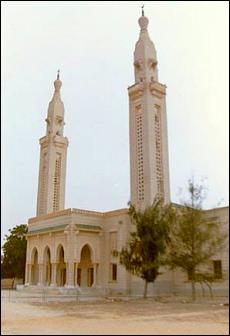
Nouakchott
Created from a grassy fertile plain in 1960, Nouakchott
is one of the newest capital cities in the world. When Senegal and Mauritania split at independence, Mauritania was left without
a capital. The site chosen was many days walk from the desert, but is now entirely surrounded by the Sahara, with sand piling
up against walls and fences like snow drifts. The city lost some of its energy (already in short supply) following the riots
in 1989, but the two markets are lively and the beach good for swimming and jogging (and, some say, mugging). Although designed
for 200,000 inhabitants, Nouakchott has about five times that population already; the outer areas are little more than slums
of metal shacks and tents.
Nouakchott, by far the largest city of Sahara, exhibits all
the problems of Mauritania. Some people are rich, but inadequate living conditions and slum are dominating, unlike what is
normal to the Muslim world. Nouakchott is one of the Arabic cities having most of "Western" problems. Drug abuse and child
prostitution are sad proofs of Mauritania's problems with entering the modern ages.
 But Nouakchott has a lot of charm, and is not a dangerous place. This city, stretching for kilometres in northern direction,
has a laid back atmosphere. People are very friendly, and there are almost just as many women in the streets as there are
men, and there are few signs of limitations to their freedom. But Nouakchott has a lot of charm, and is not a dangerous place. This city, stretching for kilometres in northern direction,
has a laid back atmosphere. People are very friendly, and there are almost just as many women in the streets as there are
men, and there are few signs of limitations to their freedom.
When you're here, you'll end up walking in the streets,
and go down to the endless beach. Inside Nouakchott, the city centre is active and with entertaining market activities going
on, mainly in the early hours of the day. The CinquiŤme district is an even better market, where handicrafts can be seen or
bought. Prices are high here, and the handicrafts, being of very good quality, are unfortunately not worth the price. Of buildings
to be seen, Nouakchott is too young to offer anything of high age. The mosque donated by Saudi Arabia in the town centre,
is impressive. So is the Moroccan one, further south.
 Nouakchott deserves to have its sunny side exposed as well, and the Tavragh Zayna and Las Palmas areas, less than half a kilometre
northwest of the town centre, indicate what the good life in Mauritania can be like. Huge and impressive villas, can be seen
from a distance, behind walls and gates. Nouakchott deserves to have its sunny side exposed as well, and the Tavragh Zayna and Las Palmas areas, less than half a kilometre
northwest of the town centre, indicate what the good life in Mauritania can be like. Huge and impressive villas, can be seen
from a distance, behind walls and gates.
  The national museum of Nouakchott offers historical and ceramic exhibitions, and should be visited for anyone who stays in
Nouakchott for more than a couple of days. The national museum of Nouakchott offers historical and ceramic exhibitions, and should be visited for anyone who stays in
Nouakchott for more than a couple of days.


Nouadibou
Also on the coast, but in the far north and literally
metres away from the Moroccan-controlled Western Sahara, is the fishing town of Nou‚dhibou. Situated on a peninsula jutting
southwards from the mainland - and only about 500m (545 yards) across - the town is on the east or bay side, with the ocean
side held by Morocco. The area is separated by landmines so go no further west than the train line. The airport is modern
- complete with muzac - but the rest of the town is basic and caked in sand. Swimmers, water-skiers and anglers will be in
heaven - the seas boast one of the largest fish populations in the world. About 520km (325mi) from Nouakchott, Nou‚dhibou
is accessible by air twice a day, train or truck (up to 30 hours). Do not attempt the drive without a guide and remember to
take eyedrops and plenty of water.
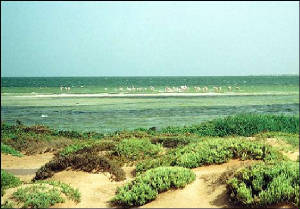
Arguin Banc
The Banc d'Arguin is a crossroads for aquatic birds migrating
between Europe, northern Asia and Africa. Over two million sandpipers have been recorded in the winter, and many species use
the national park for breeding also. The sea is crystal clear and shallow (no more than about 3m (10ft) deep 25km (15mi) from
shore) and is dotted with sand islands where the birds nest and rest. The only way to see the birds is from small boats, and
then only with permission from the national parks service, and a guide. Visitor times are strictly regulated - you are not
allowed get close to the birds during the twice-yearly mating season - so plan ahead. A 4WD is required and the trip involves
a 155km (96mi) drive along the beach - knowledge of tides is essential - then another 50km (31mi) through desert. Bring your
own boat. Arguin Bank is about 250km (155mi) from both Nouakchott and Nou‚dhibou, but even more difficult to access from the
north.
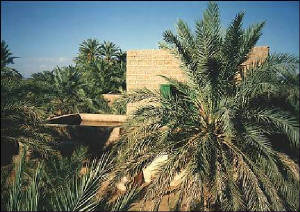
Attar
While large parts of the traditional architecture of Atar was
destroyed by floods and rain in early 1990's, this oasis, one of the largest settlements in Mauritania's north, has enough
to hold the interest of most visitors. Atar is a very lively town, an important market centre for a vast region, with nomads
coming into town in order to stock up, as well as sell their products (mainly foodstuffs and animals). Unfortunately, Atar
is starting to become a place where visitors can be harassed by the young with money or valuables in mind
 The market of Atar is active all through the week, and
one of the more interesting sections of it, is the quarter of the smiths, which provide for the local market. Their products
along with the products sold in other parts of the market, makes a museum superfluous. The market of Atar is active all through the week, and
one of the more interesting sections of it, is the quarter of the smiths, which provide for the local market. Their products
along with the products sold in other parts of the market, makes a museum superfluous.
 Of attractions Atar, offers a ksar with narrow streets, and a French fort from World War II. The date palmeraie of Atar is
a must for people spending time in Atar, green and luscious, and with an impressive irrigation system. Of attractions Atar, offers a ksar with narrow streets, and a French fort from World War II. The date palmeraie of Atar is
a must for people spending time in Atar, green and luscious, and with an impressive irrigation system.
 Atar has a number of great excursions, with stone circles 10 km to the north, or to Azougui 15 to the northwest. Atar has a number of great excursions, with stone circles 10 km to the north, or to Azougui 15 to the northwest.
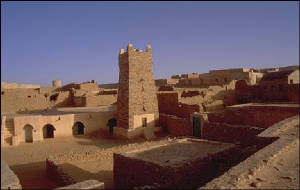
Chinguitti
The old city is fairly old, the western side dates back 700
years. The age has to do with most of old Chinguetti being constructed from stones. The main attraction in the city is the
old mosque. But as Chinguetti once was really venerated as one of the most holy cities in Islam (ranked, even today, as number
7), this is off limit to non-Muslims.
Getting there is half the fun. The crossing from Atar is shocking,
where narrow roads follow the mountain sides, even when this has made some turns of the road so sharp that they can't be done
in one turn. The nature is totally wild. The result is that this remote place is the most frequently visited tourist spot
in Mauritania. But by Mauritanian standards, this is close to nothing, anyway.
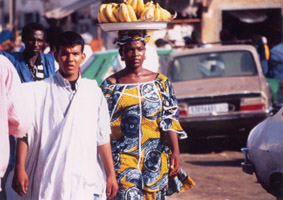
Rosso
Rosso, on the Senegalese border, is a busy town of almost 30,000
residents. Despite the large population and the large amount of passing traffic, there is actually very little to see in Rosso.
Still, the road trip from the capital is interesting - often made more so by frequent police checks - and it's possible to
visit on a day-trip. The town does boast Mauritania's only black market, but authorities take a dim view even of curious tourists,
so steer clear of anything that looks dodgy. Rosso is 160km (100mi) south of Nouakchott.
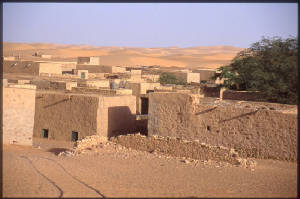
Kiffa
Kiffa has one good attraction for its visitors,
the nice market. This has a couple of distinct qualities, with local handicrafts on the offer. Except from this, the mosque
is modest but attractive.
 Apart from this, Kiffa is a typical Mauritanian village with a good number of houses spread over the red soil for a radius
of a couple kilometres. Apart from this, Kiffa is a typical Mauritanian village with a good number of houses spread over the red soil for a radius
of a couple kilometres.
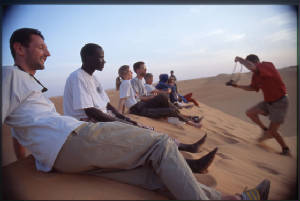
Legran
it's 35 kilometre west kiffa it's one of the most beautfull
village in mauritania surronded by montains oasis valey and canyon .
in legran you can enjoy an amazing night under stars and with
nomadic peaple .
Unfotunatly there is no hotels in legran but don't worry you will be surrounded by
bedouin's hospitality until you left
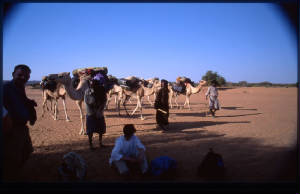
Combi Saleh
The legendary capital of the West African medieval empire of
Ghana, Koumbi Saleh is Mauritania's most famous archaeological site. Traces of the town were first uncovered in 1913 and since
then an imposing mosque has been partially excavated, adding weight to claims that tens of thousands of people once lived
there, making it possibly the biggest city in the world at that time. A lack of funds has halted excavation since the early
1980s, but plans have been formalised to complete the work. The ruins are almost 1000km (620mi) by road from Nouakchott. Flights
depart the capital weekly to AyoŻn-el-AtroŻs, which is a couple of hours' drive from Koumbi Saleh.

Tichitt
If you're exceptionally adventurous and want to see a ghost town
in the making, head east to the isolated ancient town of Tichit, 865km (520mi) due east of the capital. It lies in the centre
of a massive fault of rock streching almost to the Malian border. As a supply town it once boasted over 5000 people, but you'd
be lucky to find 500 now. Visitors are rewarded with beautiful, decorative mosques - the most ornate in Mauritania. On the
way, the landscape is a deadly mix of twisted shrubs, bleached bones, bare trees and - yes - sand. Never travel to Tichit
without a guide, and check in with the police when you arrive. Believe us, they'll be surprised to see you.
|

